| type |
The postfilter section type. This field determines which field of the MEIPostfilterSection.data union is used by meiFilterPostfilter.() methods. More information about particular filter types can be found below and in the MEIFilterType documentation. |
| form |
The form of a postfilter section. The form determines how a particular postfilter section is calculated on the controller. All forms have certain limitations and tradeoffs. Please refer to MEIFilterForm for more information. |
| lowPass.breakpoint |
The break point (measured in Hertz) of a low pass postfilter section.
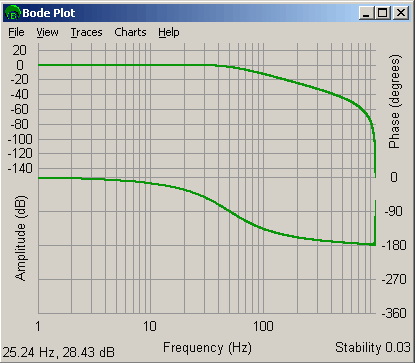
Example of a 50 Hz low pass filter.
|
| highPass.breakpoint |
The break point (measured in Hertz) of a high pass postfilter section.

Example of a 50 Hz High pass filter
|
| notch.centerFrequency |
The center frequency (measured in Hertz) of a notch postfilter section.
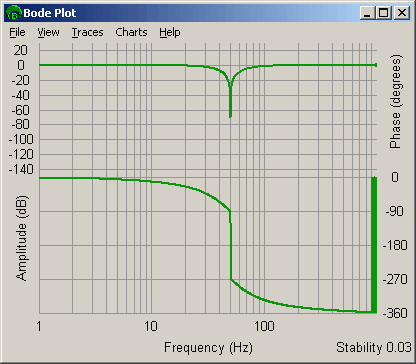
Example of a 50 Hz Center / 50 Hz Bandwidth Notch filter. Note that phase wrapping gives the illusion that phase drops 180 degrees after the center frequency. The phase raises by 180 degrees. |
| notch.bandwidth |
The bandwidth (measured in Hertz) of a notch postfilter section.
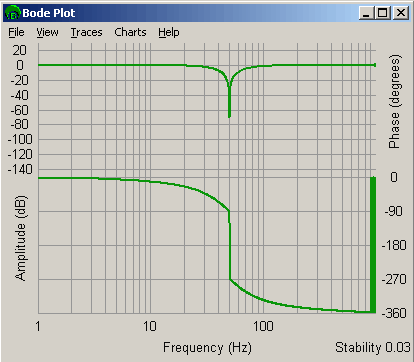
Example of a 50 Hz Center / 50 Hz Bandwidth Notch filter. Note that phase wrapping gives the illusion that phase drops 180 degrees after the center frequency. The phase raises by 180 degrees. |
| resonator.centerFrequency |
The center frequency (measured in Hertz) of a resonator postfilter section.

Example of a 50 Hz center / 50 Hz Bandwidth / -40 dB Gain Resonator filter. Note that phase wrapping gives the illusion that the phase drops 360 degrees after the center frequency. |
| resonator.bandwidth |
The bandwidth (measured in Hertz) of a resonator postfilter section.
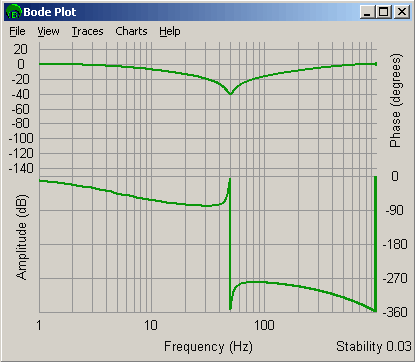
Example of a 50 Hz center / 50 Hz Bandwidth / -40 dB Gain Resonator filter. Note that phase wrapping gives the illusion that the phase drops 360 degrees after the center frequency. |
| resonator.gain |
The center frequency gain (measured in dB) of a resonator postfilter section.

Example of a 50 Hz center / 50 Hz Bandwidth / -40 dB Gain Resonator filter. Note that phase wrapping gives the illusion that the phase drops 360 degrees after the center frequency. |
| leadLag.centerFrequency |
The center frequency (measured in Hertz) of a lead or lag postfilter section. The amplitude at this frequency is the average amplitude of the low and high frequency amplitudes. The gain (measured in dB) at this point is given by:

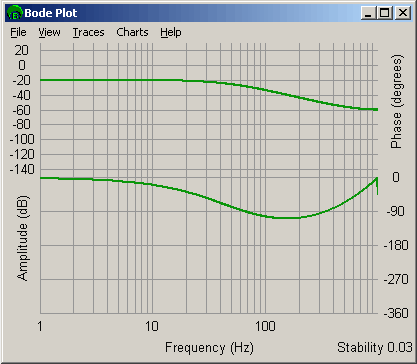
Example of a -20 dB low frequency gain / -60 dB high frequency gain / 50 Hz center lead lag filter. |
| leadLag.lowFrequencyGain |
The low frequency gain (measured in dB) of a lead or lag postfilter section.
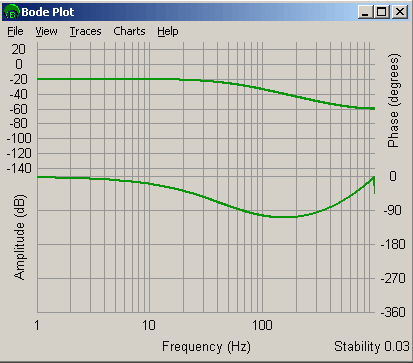
Example of a -20 dB low frequency gain / -60 dB high frequency gain / 50 Hz center lead lag filter. |
| leadLag.highFrequencyGain |
The high frequency gain (measured in dB) of a lead or lag postfilter section.

Example of a -20 dB low frequency gain / -60 dB high frequency gain / 50 Hz center lead lag filter. |
| biquad.a1 |
The analog coefficients of a single order or bi-quad postfilter section.
Analog values of the postfilter coefficients are produced as parts of a Laplace Transform:

and

|
| biquad.a2 |
| biquad.b0 |
| biquad.b1 |
| biquad.b2 |
| digitalBiquad.a1 |
The digital coefficients of a single order or bi-quad postfilter section. |
| digitalBiquad.a2 |
| digitalBiquad.b0 |
| digitalBiquad.b1 |
| digitalBiquad.b2 |
| digitalBiquad.d1 |
The digital coefficients of a state-space bi-quad postfilter section. |
| digitalBiquad.c1 |
| digitalBiquad.c2 |
| digitalBiquad.a2 |
| digitalBiquad.a1 |
| digitalBiquad.b1 |
| polesZeros.poleCount |
Analog poles and zeros. |
| polesZeros.zeroCount |
| polesZeros.pole[].real |
| polesZeros.pole[].imag |
| digitalPolesZeros.poleCount |
Digital poles and zeros. |
| digitalPolesZeros.zeroCount |
| digitalPolesZeros.pole[].real |
| digitalpolesZeros.pole[].imag |
| stateSpaceBiquad.d1 |
State space coefficients. |
| stateSpaceBiquad.c1 |
| stateSpaceBiquad.c2 |
| stateSpaceBiquad.a2 |
| stateSpaceBiquad.a1 |
| stateSpaceBiquad.b1 |
